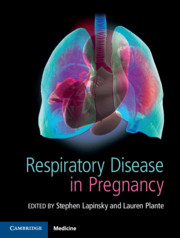Book contents
- Respiratory Disease in Pregnancy
- Respiratory Disease in Pregnancy
- Copyright page
- Contents
- Contributors
- Section 1 The Basics: for the Obstetrician
- Section 2 The Basics: for the Non-Obstetrician
- 4 Cardiopulmonary Physiological Alterations in Pregnancy
- 5 Gas Exchange across the Placenta
- Section 3 Pulmonary Conditions Not Specific to Pregnancy
- Section 4 Pulmonary Conditions Related to Pregnancy
- Section 5 Other Pulmonary Issues in Pregnancy
- Index
- References
4 - Cardiopulmonary Physiological Alterations in Pregnancy
from Section 2 - The Basics: for the Non-Obstetrician
Published online by Cambridge University Press: 14 April 2020
- Respiratory Disease in Pregnancy
- Respiratory Disease in Pregnancy
- Copyright page
- Contents
- Contributors
- Section 1 The Basics: for the Obstetrician
- Section 2 The Basics: for the Non-Obstetrician
- 4 Cardiopulmonary Physiological Alterations in Pregnancy
- 5 Gas Exchange across the Placenta
- Section 3 Pulmonary Conditions Not Specific to Pregnancy
- Section 4 Pulmonary Conditions Related to Pregnancy
- Section 5 Other Pulmonary Issues in Pregnancy
- Index
- References
Summary
Multisystem physiological changes in pregnancy are designed to provide for the increase in metabolic demand from the growing fetoplacental unit, the developing uterus and other maternal adaptations. Basal oxygen (O2) consumption increases by 50 ml/min or about 25% at term gestation, and basal metabolic rate increases similarly. There is further increased oxygen consumption during labour and vaginal delivery. Global O2 delivery is determined by the O2 carrying-capacity of arterial blood and cardiac output.
- Type
- Chapter
- Information
- Respiratory Disease in Pregnancy , pp. 25 - 33Publisher: Cambridge University PressPrint publication year: 2020
References
- 1
- Cited by



